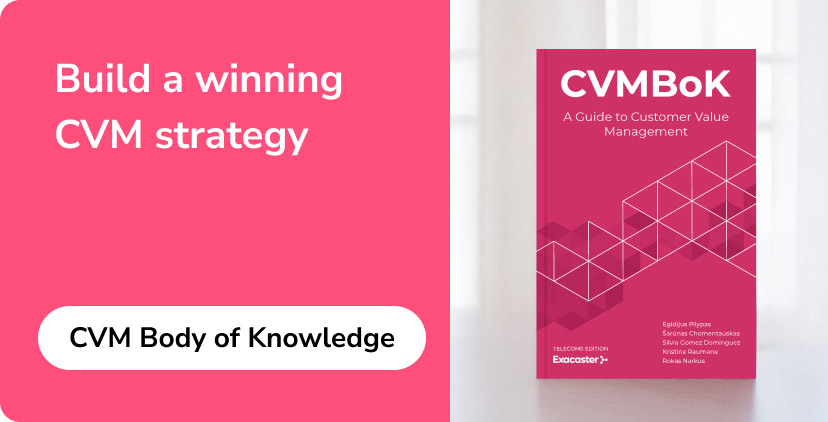To understand better the Strategic Alignment tool and it’s use to support CVM Transformation we provide an example based on a hypothetical organization called “Telecom X”.
After conducting annual planning exercise our Telecom X executives saw a dilemma: the shareholder expectations for faster growth mismatched the realities of a saturated market. At the same time a previously conducted PESTL analysis showed an opportunity where technological advancements allow both television and internet to be delivered over a single cable using existing network capabilities. With core broadband product growing slowly, Telecom X is considering to enter the market with an additional television/streaming product delivered over the same infrastructure. Given tough competition in this area, the company needs better customer needs insight to win. The organization conducts Strategic CVM alignment exercise to understand the customers and align the execution.
From Business Perspective We obtain the following inputs:
- Strategy: Most recent strategic planning exercise indicates that “Telecom X” has an opportunity to provide high-quality entertainment and connectivity needs by leveraging technological convergence to deliver both television and internet over a single cable.
- SWOT: The company has high profitability and can sustain an investment program necessary to introduce a major second product into the portfolio.
As we see in the example above Telecom X enters CVM Strategic alignment process with significant prior strategy work. CVM Strategic Alignment exercise can focus where it can add most value – on providing inputs about the customer perspective.
Understanding Telecom X’s Customer Needs
Telecom X CVM team conducts analysis of internal customer behavior data to define typical current product purchase and usage patterns, and supplements that with market research to add qualitative aspects to the analysis. As a result the company identifies that market consists of 6 major consumer segments, each with distinct needs in the intersection of broadband and TV:
- Emerging / Youth – use broadband connection provided by the parents, do not watch traditional TV but use streaming
- Surviving / Single and families doing blue-collar work – have broadband, live in apartment buildings and are heavy users of traditional TV, sports, entertainment but have price sensitivity
- Aspiring / Singles and families doing white-collar work – prefer mobile broadband and have little time for traditional TV
- Thriving / Professionals and modern families with high income – have high quality broadband requirements, multiple real estate properties, combine traditional TV with streaming but little time to use it, little price sensitivity
- Realigning / Mature families with kids out of the house – have high quality broadband requirements, multiple real estate properties, need to support kids’ families, lots of travel, more time for TV entertainment
- Retiring / Senior segment – have basic broadband requirements, are heavy users of traditional TV, price sensitive
As we can see from the example above, there are several segments where the need for a combined broadband/TV product can create a market opening. The CVM team should explore the opportunity to introduce a combined streaming, broadband connectivity and digital TV service to the consumer market, and launch the service starting from the ‘Thriving’ segment since it is least price sensitive and may potentially be the most lucrative. This is the segment that our team choses to explore further with focus group and market sizing analysis. The analysis shows the following further insights:
Victor – Thriving Segment Persona
“As successful executive with multiple properties, I value premium entertainment with multiple high-end TV sets. I require fast internet for work and leisure but face connectivity challenges in my rural property.”
Customer Perspective inputs:
- Persona: Victor – Thriving Segment. A successful executive with multiple properties, requiring premium entertainment and fast, reliable internet.
- Needs (Jobs-to-be-Done): Enjoy uninterrupted high-quality entertainment and maintain seamless connectivity for work and leisure, despite rural connectivity challenges.
- Choice: Seeking bundled service offerings that provide value and convenience, with a willingness to invest in premium services.
- The Thriving persona makes up 30% of the combined broadband / TV market by value
The detailed analysis supporting the conclusion has many further details and insights into the segment, for example:
|
The Core Functional Job-to-be-Done |
|
|
Desired Outcomes on the Core Functional Job |
|
|
Emotional and Social Jobs |
|
|
Related Jobs |
|
|
Consumption Chain Jobs |
|
|
Financial Desired Outcomes |
Willingness to invest in high-end services and technologies that enhance his lifestyle, with an emphasis on quality: improved connectivity and entertainment options. |
With the above information in place telecom X makes the following bet:
Strategic Bet: Develop and launch TV streaming product for the Thriving Segment
The long-term goal is to achieve 50% market share in the segment and grow overall revenue by 30% over the next 10 years as a result of this initiative.
There are a variety of major initiatives necessary to achieve this goal:
- Acquire a TV license
- Sign content contracts with TV channels
- Develop streaming capability
- Develop a solution to tackle rural connectivity challenges
- Launch a unified price and invoice for bundled service
- Develop a communication strategy to communicate the value proposition
- etc
To support the initiative CVM teams develops the following capabilities development plan:
CVM support for “Develop and launch TV streaming product for the Thriving Segment”
The mid-term goal is to ensure that most of existing customers who fall within the thriving segment among current customers are converted to the new product. The long term goal is to support the customer acquisition team with insights that help identify a strategy that most efficiently targets this segment in the broad market.
There are a variety of major CVM initiatives necessary to achieve this goal, and each is managed as a project within a portfolio:
- Identify thriving segment customers within existing customer base
- Identify and leverage early adopters among thriving segment to validate product prototypes
- Contribute to and test pricing, communications and sales strategies to convert existing customers to the new product
- Update sales compensation scheme to support bundled offering.
- Develop partnerships with telemarketing agencies capable of selling to the Thriving segment
- Coordinate development of data collection pipelines with data from the new product
- Develop analytical toolset to track newly acquired thriving segment customers and identify the sales and marketing channel where they originated
- Develop capability to operate constant campaigns to migrate the existing customer base to the new bundled offering.
- Develop capability to onboard bundled product customers;
- Develop capability to measure satisfaction of bundled product customers;
- etc
As you can see the CVM activity portfolio forms a crucial pillar that ensures the strategic bet of Telecom X pays off. A large number of activities are transformational, long term projects that reshape the capabilities of the organization and may involve little new staff, but radically redesigned working processes, tools and data.





